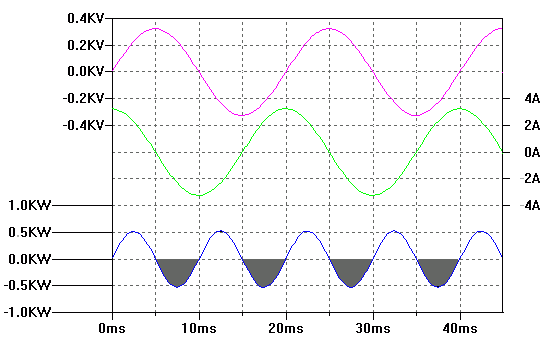|
Now let's look at exactly the same type of graph but instead of the 230 volts feeding into a 100 Ohm resistor we will feed it into a capacitor, the value of which we have chosen to draw the same curent as our 100 Ohm resistor. A resistor has "resistance". A capacitor has "reactance". They are measured in the same units (Ohms) but are very different. We have chosen a capacitor with a reactance of 100 Ohms so that the current will be the same magnitude as it was with the resistor.

Now look closely at the graph. The 230 volt waveform is identical to the previous graph. The current waveform is exactly the same magnitude as the previous graph but the waveform is in a different place on the time axis. The current seems to "happen" before the voltage that is driving it by a quarter of a cycle. It is said to be leading the voltage by 90 degrees. A capacitor causes the voltage and current to be out of phase. A perfect capacitor will always have its current leading the voltage by 90 degrees.
Now remember that the power is the instantaneous voltage multiplied by the instananeous current. If you do the same thing on this graph you will, of course, end up with the power trace (in blue) at the bottom.
And this is where it starts to get interesting.
The power trace starts at zero, rises to about 500 watts, then returns back to zero. It then reverses and becomes negative. How can we have negative power?
Easy, the power is now being returned to the source, be it a generator, inverter or the national grid.
The area on the power trace that is shaded in grey is where the power is being returned to the source. You will see that the top part of the power trace shows power going into the load, the bottom part shows it being returned. They are exactly the same size. There is actually no power being consumed in the load. It borrows some (which it stores) for a quater of a cycle, then returns it to the source on the next quarter cycle. For the technically minded, in the case of a capacitor, the energy is stored in the electric field between the two plates of the capacitor.
To the uninitiated this seems ridiculous but it is indeed exactly what happens with a perfect capacitor.
We will now look at a similar graph using an inductor............
|
Page last updated 02/04/2008.
Website best viewed on a computer of some sort.